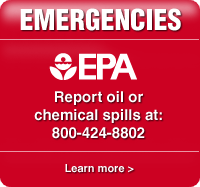Emergency Planning and Community Right-to-Know Act (EPCRA)
The Emergency Planning and Community Right-to-Know Act (EPCRA) of 1986 was created to help communities plan for emergencies. EPCRA requires state and local governments, Indian tribes .
Learn about EPCRA

- What is EPCRA?
- Amendments to EPCRA: America's Water Infrastructure Act
- EPCRA (Non-Section 313) Regulatory Amendments
- EPCRA (Non-Section 313) Guidance
- Frequently Asked Questions and EPCRA Call Center
- EPCRA Regional Contacts
Tier I and II Reporting
Forms and Instructions

- Tier2 Submit™ Software
- Tier II Forms and Instructions
- Physical and Health Hazards Cross-Walk
- Tier I Forms and Instructions
- State Tier II Reporting Requirements and Procedures
Emergency Planning
in My Area

- Local Emergency Planning Committees
- State Emergency Response Commissions
- Chemical Emergency Preparedness and Prevention on Tribal Lands
Emergency Release Notification

- State Contact Information for Emergency Release Notification
- EPCRA Section 304 Release Notification Requirements
- CERCLA Section 103 Release Notification Requirements
- Continuous Release Reporting
EPCRA Training

- EPCRA (Non-Section 313) Online Training for States, Tribes, LEPCs, Local Planners and Responders
- Workshops in New England
- 2020 Tier2 Submit™ Tutorial
Trade Secrecy under EPCRA


Copy and paste the following code into your Web page

http://www2.epa.gov/home/report-spills-and-environmental-violations ">
Click the "X" or press "Esc" to close this window.
CERCLA and EPCRA Reporting Requirements
On June 4, 2019, EPA Administrator Wheeler signed a final rule to amend the emergency release notification regulations under EPCRA. This amendment adds a reporting exemption for air emissions from animal waste at farms. For more information, please see: CERCLA and EPCRA Reporting Requirements for Air Releases of Hazardous Substances from Animal Waste at Farms.
EPCRA Trade Secrecy Claims Amendment
On July 24, 2020, EPA published a technical amendment to remove the outdated substantiation form for trade secrecy claims from the Code of Federal Regulations. The most current substantiation form is posted on EPA program websites. The Agency is also including clarification within a note in 40 CFR 355.41 to make regulated entities aware that SERCs and/or LEPCs may have a specific format for the follow-up report of the emergency release notification information. For more information, please see: EPCRA (Non-Section 313) Regulatory Amendments.
Most Requested Documents
- Consolidated List of Lists
- EPCRA Tier II Form Instructions
- EPCRA Tier II Form
- EPCRA Fact Sheet
- EPCRA Guide for Oil and Gas Operations
- Hazardous Chemical Reporting Advisory: Facilities Operating in the Plastics Industry









